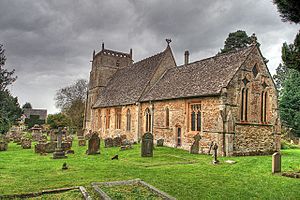Church of St Laurence, Wyck Rissington facts for kids
Quick facts for kids Church of St Laurence |
|
|---|---|
 |
|
| Lua error in Module:Location_map at line 420: attempt to index field 'wikibase' (a nil value). | |
| Denomination | Church of England |
| Architecture | |
| Heritage designation | Grade I listed building |
| Designated | 25 August 1960 |
| Administration | |
| Diocese | Gloucester |
| Province | Canterbury |
The Church of St Laurence is an old church located in Wyck Rissington, a village in the Cotswold District of Gloucestershire, England. It was built a very long time ago, in the 12th century. This church is considered very important and special, which is why it's a Grade I listed building. This means it's protected because of its history and unique design. It belongs to the Church of England.
Contents
History of St Laurence Church
The Church of St Laurence was built in the 12th century. However, there was an even older Saxon church on the same spot before it. Parts of the tower might even be from that earlier Saxon building. In 1269, the church was officially blessed and set apart for holy use by the Bishop of Worcester. This special ceremony is called a consecration.
Changes Over the Years
In 1822, new parts called transepts were added to the church. These are like arms that stick out from the main body of the church. Later, in 1879, the church had a big makeover. This was part of a "Victorian restoration" led by John Edward Knight Cutts. During this time, many old churches were updated to look new and grand.
A famous musician, Gustav Holst, worked at the church in 1891. He was the organist, playing music for services, and also the choirmaster, leading the church choir.
The bells in the church tower were fixed and rehung in 2012. This made sure they could ring clearly for many more years. The church is part of a group of churches called a benefice, which is centered around Bourton-on-the-Water. This group is part of the wider Diocese of Gloucester.
Architecture and Design
The Church of St Laurence is made from limestone, a type of stone. Its roofs are covered with stone slates. The church has a main area called the nave, which is where people sit. It also has a north aisle, which is a walkway along the side, and a porch at the entrance. There is a chancel, which is the part of the church near the altar, and a tall tower at the west end.
Inside the Church
The chancel still has its original roof, which is made of trussed rafters. This means the wooden beams are arranged in a special way to support the roof. The four-stage tower is held up by strong supports called buttresses. These are thick walls that help keep the tower stable. The edges of the roof are decorated with corbel tables, which are rows of small stone carvings.
Inside the church, you can see a round stone basin called a tub font. This font, used for baptisms, dates back to around 1200. The altar table, where the communion service takes place, is from the 17th century. Most of the other things inside the church, like the pews and other furniture, were added in the 19th or 20th centuries.
There is also a special set of 12 carved wooden plaques. These plaques show different scenes from the life of Jesus. People believe they came from a place called Flanders (now part of Belgium) and were made in the 16th century.

